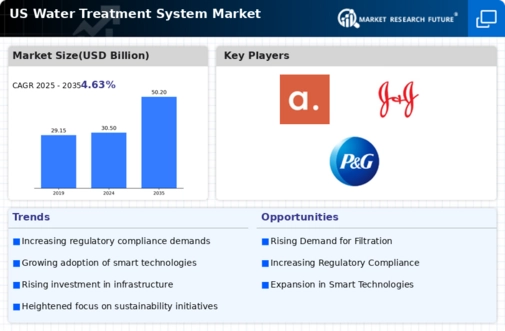Rising Health Awareness
Heightened awareness of health issues related to water quality is significantly influencing the water treatment-system market. Consumers are increasingly concerned about contaminants such as lead, bacteria, and chemicals in their drinking water. This awareness has led to a surge in demand for home water treatment systems, which are perceived as essential for ensuring safe drinking water. Market data suggests that the residential segment of the water treatment-system market is growing at a rate of approximately 8% annually. As public health campaigns continue to educate citizens about the importance of clean water, the market is likely to see further expansion, with innovative solutions being developed to meet consumer needs.
Environmental Regulations
Stringent environmental regulations are a critical driver of the water treatment-system market. The US Environmental Protection Agency (EPA) enforces regulations that mandate the treatment of wastewater and the removal of harmful contaminants from drinking water. Compliance with these regulations is essential for municipalities and industries, leading to increased investments in advanced water treatment technologies. The market is responding to these regulatory pressures by developing innovative solutions that not only meet compliance standards but also promote sustainability. As regulations evolve, the water treatment-system market is expected to grow, with companies focusing on creating systems that are both effective and environmentally friendly.
Increasing Water Scarcity
The growing concern over water scarcity in the United States is a primary driver for the water treatment-system market. As population density increases and climate change exacerbates drought conditions, the demand for efficient water treatment solutions rises. According to recent data, approximately 40% of the US population is affected by water scarcity, prompting municipalities and industries to invest in advanced water treatment technologies. This trend indicates a shift towards sustainable practices, as organizations seek to recycle and reuse water. The water treatment-system market is likely to see substantial growth as stakeholders prioritize the development of systems that can effectively address these challenges, ensuring a reliable water supply for both residential and commercial use.
Technological Innovations
Technological innovations are reshaping the landscape of the water treatment-system market. Advancements in filtration, membrane technology, and smart water management systems are enhancing the efficiency and effectiveness of water treatment processes. For instance, the introduction of IoT-enabled devices allows for real-time monitoring and management of water quality, which can lead to significant cost savings and improved outcomes. The market is witnessing a shift towards automation and data-driven solutions, which are expected to drive growth. As these technologies become more accessible, the water treatment-system market is likely to expand, catering to both industrial and residential sectors seeking to optimize their water treatment capabilities.
Investment in Infrastructure
Significant investment in water infrastructure is driving the water treatment-system market in the United States. The American Society of Civil Engineers estimates that the US requires over $1 trillion in water infrastructure improvements over the next two decades. This investment is crucial for upgrading aging systems and ensuring compliance with safety standards. As municipalities allocate funds for modernizing water treatment facilities, the market is expected to expand. Enhanced infrastructure not only improves water quality but also increases efficiency in treatment processes. Consequently, the water treatment-system market is poised for growth as new technologies and systems are integrated into existing frameworks, addressing both current and future water quality challenges.














Leave a Comment